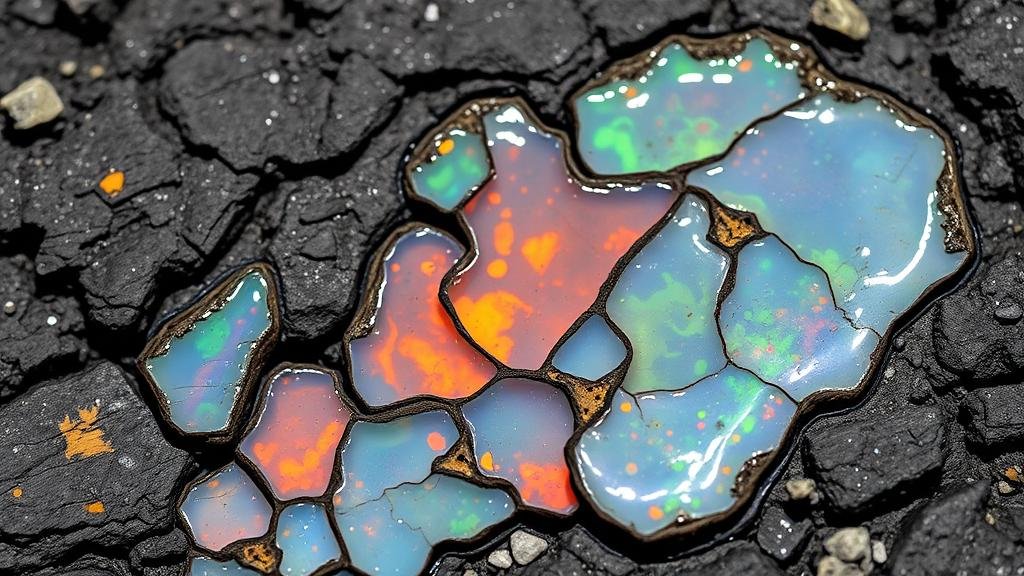Investigating opalized wood in volcanic ash deposits along the edge of the Mimbres Valley.
Investigating Opalized Wood in Volcanic Ash Deposits along the Edge of the Mimbres Valley
The Mimbres Valley in New Mexico is not only known for its rich cultural history but also for its unique geological features. One of the most fascinating aspects of the region is the presence of opalized wood found within volcanic ash deposits. This article delves into the processes of opalization, the significance of the findings, and practical insights for rockhounds and mineral collectors interested in this gemological curiosity.
Understanding Opalization
Opalization is the process whereby organic material, such as wood, is gradually replaced by opal, a mineraloid composed of hydrated silica. This occurs under specific conditions often associated with volcanic activity, where silica-rich fluids permeate the wood and crystallize over time. In the case of the Mimbres Valley, the opalized wood has been dated to the late Cretaceous to early Tertiary period, approximately 65 to 45 million years ago.
The transformation from wood to opal is akin to a natural sculpture, with the details of the original plant life preserved in stunning forms. Researchers have employed methods such as scanning electron microscopy to analyze the microstructures of opalized wood, which showcase intricate patterns and colors unique to each specimen.
The Geological Background of the Mimbres Valley
The Mimbres Valley lies along the western edge of the Sierra Madre in New Mexico, characterized by its volcanic ash deposits. e deposits are remnants of ancient volcanic eruptions, responsible for enriching the soil and creating an environment conducive to fossil preservation. The valleys geological history is marked by several significant volcanic events, which have contributed to the formation of opalized wood.
Statistics indicate that over 25% of the valley is covered by volcanic ash deposits, providing a unique setting for the formation of opalized specimens. These deposits can reach depths of up to 30 feet, often containing layers of ash interlaced with organic materials. high silica content of the ash is crucial in the opalization process, allowing for efficient mineral replacement.
Identifying Opalized Wood
Identifying opalized wood requires a discerning eye and a basic understanding of its characteristics. Here are some key identification tips:
- Color Variations: Opalized wood can exhibit a range of colors, from milky white to shades of blue, green, and even orange, depending on the impurities present during the opalization process.
- Texture: Good specimens often retain the bark and wood grain textures, making them visually appealing.
- Hardness: Opals are generally softer than quartz, rating between 5.5 to 6.5 on the Mohs scale.
Collecting Tips for Rockhounds
For those eager to collect opalized wood in the Mimbres Valley, adhering to proper techniques ensures both a rewarding and responsible experience:
- Research Locations: Identify specific sites known for opalized wood deposits. Local geological surveys or university studies can provide valuable information.
- Equip Properly: Bring tools such as rock hammers, chisels, and safety goggles for excavation. A field guide on local geology may also enhance your collecting experience.
- Follow Regulations: Ensure you are compliant with local laws regarding fossil collection. Some areas may require permits or have restrictions in place.
Conclusion
Investigating opalized wood within the volcanic ash deposits of the Mimbres Valley unveils a rich tapestry of geological and evolutionary history. For rockhounds and mineral collectors, this unique material serves not only as a beautiful specimen but also as a connection to ancient environments and processes that shaped our planet.
To wrap up, collectors should approach their pursuits with respect for the natural environment and its geological marvels, ensuring that these treasures remain protected for future generations to admire and study.


